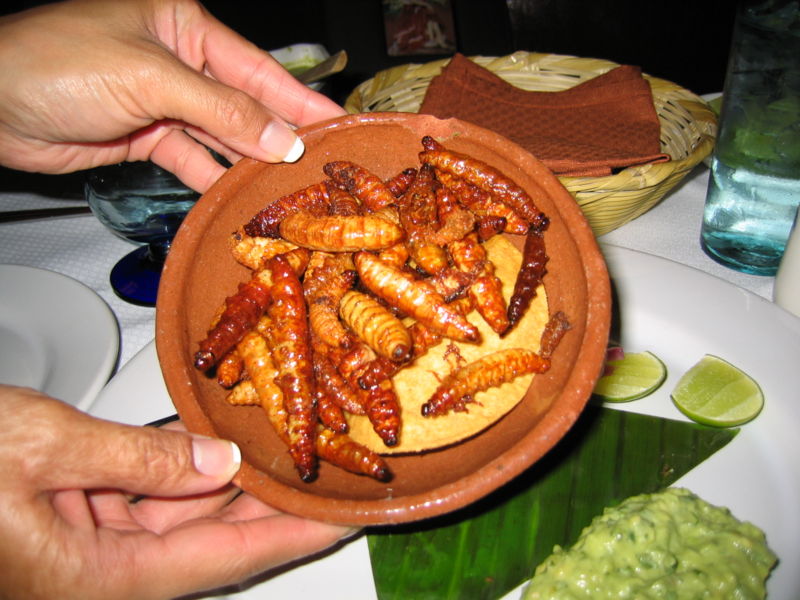
Blacklick Woods Metro Park is offering a delightful program for food lovers with a taste for something new and exotic. Join us at the nature center on Sunday August 20, 2pm, and welcome to the world of entomophagy, also known as the practice of eating insects. (You don’t have to eat anything, but samples will be available. And you’ll learn a lot about nutrition and world culture, even if you don’t fancy a bite to eat at the program).
As unappealing as the concept of eating insects may seem, it is common for more than two billion people on planet Earth. To those of you who can’t even fathom eating an insect, please stay with me.
Logic reminds me that insects are already a part of the food industry in the United States. The Food and Drug Administration has guidelines on the acceptable amounts of insects and insect parts that are permissible in our food. Such things are considered food defects, not contaminants, as they pose no health hazard. In fact, as icky as it may sound, separating insect fragments from every part of our food is considered unavoidable.
Now, understanding that I have likely already unintentionally consumed insects, could I do so of my own free will? Curiosity propelled me to better understand the appeal of this practice, here’s what I discovered.
There are actually many reasons to choose these six-legged organisms as a snack or a meal. One reason people consume insects is simply the taste. To many people, insects are considered a delicacy. They can be sautéed, fried or baked and seasoned in a multitude of ways; sweet, savory, sour; or simply unseasoned. Roasted crickets, for example, are commonly described as nutty tasting and surprisingly not “buggish.” Mealworms have been described as tasting similar to toasted almonds.
Insects are also incredibly nutritious. Many are about 60 percent protein, depending on the species. This includes the most commonly consumed insects, such as beetles, bees, wasps, ants, grasshoppers, crickets and the larvae of various species. When compared to traditional protein sources, insects can actually have more protein pound for pound. One pound of crickets has 31 grams of protein, compared to just 20.4 grams of protein in one pound of farm raised salmon and 22.4 grams of protein in one pound of lean beef.
Not only do insects have more protein per pound but they also take fewer resources to produce. To raise one pound of edible crickets, you only need two pounds of food, plus one gallon of water. The same resources, two pounds of food and one gallon of water, would barely feed a single cow for one day.
If that’s not impressive enough, consider housing requirements. Just 24 square feet of space, which is slightly larger than an average bath tub, can yield 30 pounds of edible crickets.
To some insect indulgers the appeal of eating insects isn’t strictly for its taste or nutritional content but for its environmental sustainability. One of the most interesting and compelling components of insect eating is that it is significantly less taxing to the environment and our natural resources.
Insects emit far fewer greenhouse gases than livestock and consume significantly less natural resources, especially water. This makes entomophagy a sustainable, eco-friendly practice. The cultivation of insects has a noticeably smaller ecological footprint, especially when compared to current industrialized animal farming practices. Such practices release methane into the atmosphere at an astounding rate. This increase in greenhouse gas may contribute to the acceleration of climate change, not to mention it creates a calculated 133 million tons of manure a year.
Often the insects that are being raised and harvested can thrive on basically anything, even organic waste. Cultivating insects for human consumption, as opposed to raising animals that use millions of pounds of feed, seems like a smart move, as the food used to raise traditional protein requires substantial water, fertilizer and space to grow. But why is eating insects so unpopular in America?
Culture shapes our behavior, as well as our diet. Insect eating occurs world wide and across various cultures. It seems reasonable to eat what is readily available and there are more insects in this world than all other animals combined.
Perhaps in more tropical regions of the world, where insects are larger and occur in greater numbers, the sheer amount of insects available has helped them gain popularity as a food source. One can speculate the myriad of reasons these six-legged organisms have not fared well in the west, but what cannot be disputed is that this diet diversity is slowly catching on to places it has historically been unpopular, like Europe and you guessed it, the United States.
Many believe entomophagy is the future of food. Join me on August 20 and let’s enjoy the food and satisfy our curiosity about this world-wide practice. For those wanting to explore the world of insect eating, I invite you to Blacklick Woods Metro Park’s nature center on Sunday, August 20 at 2pm for the Explore the World of Eating Insects program. Those curious about entomophagy will learn more about the practice and have the opportunity to sample what it’s all about.
BETH RENNER
Blacklick Woods Naturalist
EXPLORE THE WORLD OF EATING INSECTS
Sunday August 20, 2pm
Blacklick Woods Nature Center
